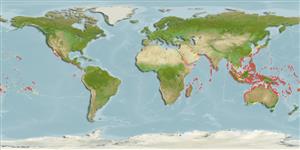Common names from other countries
Teleostei (teleosts) >
Perciformes/Scorpaenoidei (Scorpionfishes) >
Scorpaenidae (Scorpionfishes or rockfishes) > Scorpaeninae
Etymology: Scorpaenodes: Latin, scorpaena = a kind of fish, 1706 + Greek oides = similar to (Ref. 45335).
More on authors: Quoy & Gaimard.
Environment: milieu / climate zone / depth range / distribution range
Ecology
Marine; reef-associated; depth range 0 - 20 m (Ref. 106975), usually 0 - 5 m (Ref. 89972). Tropical; 35°N - 40°S
Indo-Pacific: from the east coast of Africa and the Red Sea east to the Society Islands.
Size / Weight / Age
Maturity: Lm ? range ? - ? cm
Max length : 14.0 cm TL male/unsexed; (Ref. 9710)
Dorsal spines (total): 13 - 14; Dorsal soft rays (total): 7 - 9; Anal spines: 3; Anal soft rays: 5. Thie species is distinguished by the following set of characters: pectoral-fin rays 17-20 (mode 18), some rays branched in specimens over ca. 40 mm SL; dorsal-fin soft rays 7-9 (8); scale rows in longitudinal series 40-46 (43); underside of lower jaw scaleless; gill rakers 11-15 (13); with nasal spine; lateral lacrimal spine is usually present; suborbital spines 2, first spine below eye, second spine at end of suborbital ridge; no interorbital and coronal spines; opercle with a large dark blotch; no dark blotch on subopercle or spinous portion of dorsal fin (Ref. 106975).
Found in rock crevices in reef flats, shallow lagoons, and channels. Feeds mainly at night on small shrimps, crabs, and polychaetes. Anterolateral glandular groove with venom gland (Ref. 57406). Solitary and cryptic (Ref 90102).
Life cycle and mating behavior
Maturities | Reproduction | Spawnings | Egg(s) | Fecundities | Larvae
Motomura, H., R. Causse and C.D. Struthers, 2015. Redescription of the Indo-Pacific scorpionfish Scorpaenodes guamensis (Quoy & Gaimard 1824) (Scorpaenidae), a senior synonym of seven nominal species. Zootaxa 4067(3):345-360. (Ref. 106975)
IUCN Red List Status (Ref. 130435)
CITES (Ref. 128078)
Not Evaluated
Human uses
Fisheries: of no interest
Tools
Special reports
Download XML
Internet sources
Estimates based on models
Preferred temperature (Ref.
115969): 24.3 - 29.3, mean 28.2 (based on 3057 cells).
Phylogenetic diversity index (Ref.
82804): PD
50 = 0.5000 [Uniqueness, from 0.5 = low to 2.0 = high].
Bayesian length-weight: a=0.01413 (0.00918 - 0.02174), b=3.00 (2.88 - 3.12), in cm Total Length, based on LWR estimates for this species & (Sub)family-body (Ref.
93245).
Trophic level (Ref.
69278): 3.4 ±0.50 se; based on food items.
Resilience (Ref.
120179): Medium, minimum population doubling time 1.4 - 4.4 years (Preliminary K or Fecundity.).
Fishing Vulnerability (Ref.
59153): Low vulnerability (10 of 100).
